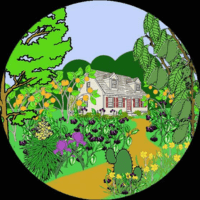How to Grow and Care for Fig Trees
Grow Fig in your yard or indoors. However, there are many types of figs to choose from! Select a dwarf or standard size tree. Or with very large or moderate sized fruit. Ripe fruit may be black, purple, green-yellow or striped! Fig tree care is easy. They are very adaptable to soils and sunlight, and are disease and pest free plants.
Humans have cultivated figs since the Neolithic age (like the Plum, btw). They originate from Asia (Turkey through Northern India) and quickly spread through the Mediterranean. Cultivated varieties were established across the Mediterranean region ~6000 years ago. The Greek and Romans grew and ate them extensively. Soon, the tree spread through Europe and the Americas. It’s a HIGHLY adaptive, easy-to-grow fruit tree.
Eat the fresh fruit or make whole fig jam. Be adventurous and use the fruit with cheese and meats. Or, eat dried fig, as done for thousands of years. Fig recipes are below. The fruit is fat-free and cholesterol-free, and provides vitamins, minerals, polyphenols, flavonoids, and fiber.
We grow Ficus carica organically. However, dwarf figs trees are our new favorite type and we explain why.
Finally, the tree has weird characteristics! However, ‘every day’ gardeners should focus on selecting the types of figs as WE define it. The technical information about weird characteristics is for nurseries, farmers and other commercial producers.
________________________________________
see our list of 400 edible plants
YouTube channel (please subscribe)
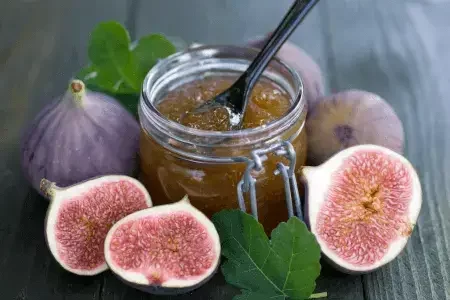
Fig Trees in garden design, permaculture, and organic gardening
Fig, Ficus carica
common names: literally NO other common name!
Fact Sheet
Zone: 7-11
Height: 6 – 20 feet (and wider)
Native: North America
Bloom Time: April (blooms are NOT noticeable)
Bloom Color: green (blooms are NOT noticeable)
Fruit Maturity: August – October
Self-fertile: yes
Sun: full sun (will tolerate heavy shade)
Water: medium (mature trees tolerate drought)
Soil: adaptable (wide range)
Maintenance: little
Growth Rate: fast
Deciduous or evergreen: deciduous
Edible¹: yes (discussed below)
Medicinal²limited (discussed below)
Commercial viability: strong
Family / Genus: Moraceae / Ficus
Remarks: our trees are 100% pest/disease free; soft sweet fruit attracts insects (pick the fruit or it becomes someone else’s food 😉
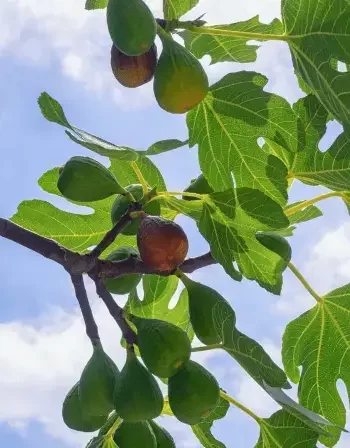
As an Amazon Associate, HEPPY earns from qualifying purchases (paid link).
Here’s a list of all the products we truly use and trust.
Type of Fig Trees
“Type of fig trees” can mean many things. We keep it simple. Select the type of fig tree for your plant zone (cold hardiness). Our recommendation is to look at your USDA Plant Hardiness Zone. Then, select a type of fig tree for size. Some varieties get BIG and some dwarf. Finally, select a type fig tree for fruit color and flavor. There are so many varieties to choose from.
You may also read “Type of fig trees” in a more technical context. Not simple. However, the technical information is of little consequence for regular gardeners. It’s TMI on steroids unless you’re a commercial operation (eg., Common, San Pedro, Smyrna or Capri trees; and, Breba vs. Main Crop, etc.). I address the technical mumbo jumbo at the bottom of this page.
We do NOT select a type of fig tree based on the technical stuff; we select the type of fig tree based on cold hardiness, size and cool characteristics (fruit size, color & flavor).
Type of Cold hardiness
Only a few varieties truly tolerate zone 7 or colder weather. Zone 6 is about the limit. Know your plant zone.
Zone 6:
The Chicago Hardy (aka, Hardy Chicago) may grow in zone 6. The Celeste and Olympian Hardy may survive this zone too. Zone 6 is COLD for a Mediterranean tree! The growth above-the-ground may die. However, the roots will survive and she’ll bounce back just fine! There are steps to take for winter protection.
Zone 7:
Winters can kill many fig trees even if they’re “rated” to grow in zone 7. It is best to protect newly planted or young trees so that the roots survive. Loosing the growth above ground is unfortunate. However, loosing the roots means loosing the plant entirely. There are steps to take for winter protection.
Zone 8 and higher:
Carry-on, and have fun!
Type of tree size, Dwarf or Standard
There are very few dwarf fig trees. Otherwise, they grow to a standard height.
Dwarf
Fignomenal, Little Miss Figgy and Petite Negra are the three varieties that are described as dwarf. An Olympian Hardy dwarf fig is mentioned but I cannot find a genuine, reliable source. We grow the Little Miss Figgy and Petite Negra!
Standard
I place all other fig trees in the “standard” size category. If it’s labeled to grow 10-15 feet AND is placed in ideal soil, you will get a 20’+ tree. Conversely, a fig tree labeled 20′ may not reach that height in bad soil.
Our super-charged rich soil created a monster fig tree. I featured it on YouTube!
Type of fruit color and flavor
Ripe fig fruit display a WIDE variety of skin and flesh colors. Flavors are on a narrow spectrum, and ripe fruit is sugar-sweet.
Skin and Flesh colors
Skin color include black, bronze, green, mahogany, purple, violet, and yellow. Some varieties of Ficus carica have stipes! The Panache Tiger and Popone produce striped fruit.
Flesh color
Flesh color are variations of amber, pink, and red. For example, the Lebanese Red Fig Tree has bright strawberry red flesh.
Flavor
Ripe fruit vary in flavor. Flavors are often described as honey, berry-like or caramel. Then there’s the intensity of those flavors. For example, mild caramel or rich caramel.
Climate “fit”
One Green World provided excellent insight.
Grow figs in the Southwest
Grow almost any variety of fig in regions with dry summers. The southwest includes mountainous regions so be sure to know the plant zone. Overall, the dry and hot climate is closest to the fig’s native environment.
Grow figs in the Southeast
LSU Purple, Hunt’s, Champagne, Scott’s Black and Celeste trees are recommended for wet summer regions. The fig fruit is less likely to split.
Grow figs in Northern climates
Back to the plant-zone issue. The Celeste, Chicago Hardy and Olympian Hardy are often cited for zone 6.
HEPPY™ is in Maryland, zone 7b. Our Brown Turkey or Chicago Hardy have some splitting. Otherwise, the Kadota and dwarf fig tree fruit do well.
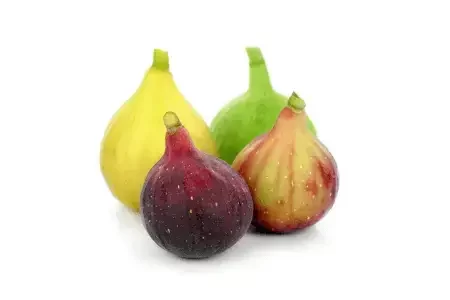
Fig trees in landscaping and garden ideas
Select a tree-size, fruit color and be sure it grows in your plant zone! Few figs tolerate zone 7 or colder weather (Zone 6 is about the limit)
Landscape Architecture
Fig trees in landscape architecture? Yes! It is a spectacularly large-leafed tree in full sun. Imagine a single accent plant in a open lawn. However, the root system is vigorous, and it typically grows as a multi-stemmed tree. Use the tree as buffer, such as for a fence-line. Also, we grow two trees in heavy shade. They are along a stream for erosion control, because of its vigorous root system. They do very well!
Garden Ideas
Fig tree fit any garden. However, be mindful that the standard sized fig tree can grow large! We now grow dwarf figs trees are our new favorite type and we explain why.
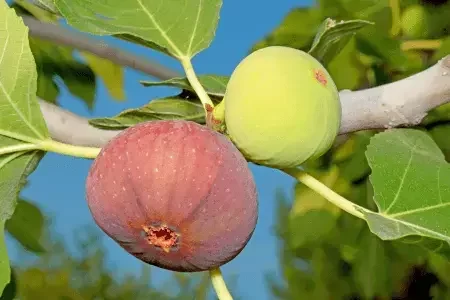
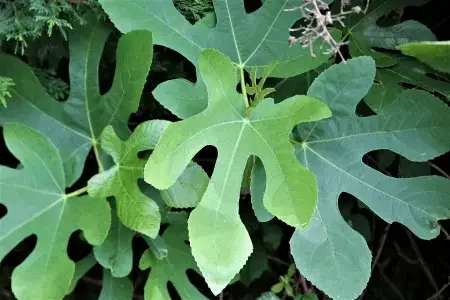
As an Amazon Associate, HEPPY earns from qualifying purchases (paid link).
Fig tree care
Sunny, well-draining organic soil is optimal. Be mindful of their vigorous root system. Ficus carica are adaptable and are drought tolerant once established.
Location
They have a vigorous root system. Consider a location AWAY from plumbing, skeptic tank fields, and other infrastructure. However, there’s always dwarf fig trees. We love our dwarfs!
When to plant
It’s best to plant all fruit trees when they are dormant or, when it’s not hot. However, plant after the risk of a winter freeze if planting in zones 6 or 7.
Sunlight
Full sun is best. However, we tested two trees and planted them in heavy shade. They grow along a stream bank for erosion control. They grow great! They grow a little “lanky” and don’t fruit as well as fig trees in full sun.
Full sun assures a healthy tree and the most fruit.
Soil
Fig tolerate almost any soil, and grow in nutritionally poor soil. However, it will not be healthy or, take a long time to establish.
Preferred soil is well-draining and organic. Ficus carica thrive in organic soil. Straw, leaves or woodchips are ideal and free soil amendments.
Watering
It depends. Overall, the Ficus carica is extremely drought tolerant once established. In fact, commercial production is concentrated in dry hot summer climates.
Watering young or newly planted trees
Regularly water young trees (once / twice weekly, when it’s not raining). Water newly planted trees more frequently until established (2 months minimum).
Water well during the warm months. However, there’s no reason to water overwinter, when the tree is dormant.
Watering depends on your soil
Is the soil well-amended with decayed woodchips or compost? Then a LOT LESS water is needed.
Fertilizing
I stopped fertilizing our fig trees. Our soil is very rich, and the tree’s roots grow far and wide. Also, we mulch younger trees annually. A paper from the USDA sheds light on fertilization. “Fig orchards do not require regular fertilization unless grown on sand, and excessive application will encourage plant growth at the expense of fruit production. No more than 0.2 to 0.5 kg N should be applied per tree per year, with split applications from early spring through July (Morton, 1987). Nitrogen is the only nutrient that is regularly applied to fig orchards.
Additionally, applying too much nitrogen encourages excessive plant growth that’s soft. That excessive soft wood is more likely to die by a winter freeze in our plant zone (zone 7).
Finally, the excessive growth means more pruning. Altogether, we DON’T fertilize our mature fig trees.
Pruning
Prune established fig trees as needed. They respond well to pruning. In fact, 15′ tall fig tree is pruned to 3-4′ tall just to manage her explosive growth (in highly organic soil).
As with all fruit trees, prune away dead wood and branches that grow towards the tree’s. Low-limbs under at tall tree will be more unproductive. They too can be pruned.
Winter protection
Growing fig trees outdoors in zones 6 and 7 has the risk of “winter injury” or, loosing the plant altogether.
Winter injury
Winter injury is the general term for having branches and limbs die overwinter. However, the roots live.
Reduce winter injury by using less or no fertilizer. Instead, mulch in early spring. Use decayed woodchips and compost for nutrients.
Fertilizer will stimulate vigorous growth. Portions of the growth will be very soft wood. Soft, young shoots and growth will get ‘zapped’ by winter-cold and die. Go low-and-slow because Ficus carica grow fast enough!
Winter survival
Winter weather can kill the roots. Young and newly planted trees are most vulnerable. There are strategies to increase soil temperature and to create an insulated blanket around the fig.
- Surround the fig with leafy debris. To keep debris in-place, encircle with chicken wire, netting or horticultural hessian.
- We set cinder blocks on the northern side of dwarf figs. This captures heat from the winter sun.
- For young dwarf plants, use inexpensive pop-up greenhouses. See what we used on YouTube. Use them as-is, or add insulating materials to the product. Polycarbonate panels are reliable.
- One Green World mentioned “bending the plant all the way over and burying it in a trench filled with leafy debris and soil.” I see this as a good strategy. However, it obviously depends on your tree size.
Edible Figs
1, 2 HEPPY cannot take any responsibility for any adverse effects from the use of plants. Always seek advice from a professional before using a plant for food or medicinally. This information is intended for educational purposes only and should not be considered as a recommendation or an endorsement of any particular medical or health treatment.
NOTE: the fig tree’s leaves and fruit have a white, milky sap. The sap may cause contact dermatitis or other skin irritation for some people. Fig leaves may cause the same for highly sensitive people. Evaluate and understand your physical vulnerabilities. I’ve not met anyone who had an adverse reaction. However, I’ve not met you at a fig tree….
Figs can be eaten fresh and in MANY dishes. It can be incorporated into sweets however, it adds a flavor that contrasts well with cheese and meats. One raw fig is about 37 calories. Or, eat dried fig. That’s been done for thousands of years. The fruit provides magnesium, potassium, calcium, and iron.
Ripe fig
Ripe fig fruit last about a week in a refrigerator. They can can be eaten in cereals, as a snack, and in yogurt or ice cream. One fig is about
Recipes with Figs
CaliforniaFigs.com has ad-free webpage with high-end recipes! They have hundreds of recipes such as Fig Chicken Cacciatore, Fig Beef Chili Tamale Pie, and Creamy California Fig Penne with Chicken and Walnuts! Use the filter in the left margin. This is a BEST website for recipes!
CanadianFigs.ca also provides excellent recipes on an ad-free webpage. In a salad, with chicken or cheese, in granola, tarts and a LOT more!
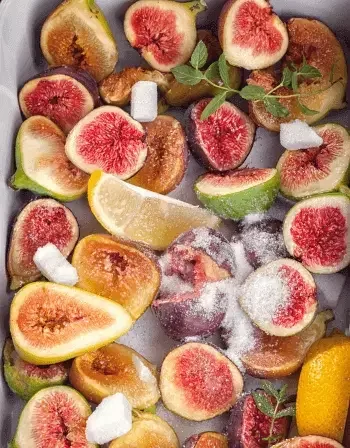
Whole fig jam recipe with sugar
Fig jam recipes are LOADED with sugar. Sugar helps canned fruit hold its shape, color and flavor, but sugar is not needed to prevent spoilage.
A normal, full-sugary recipe is about 75% fig, 25% sugar. Measure by cups, pounds or whatever. Lemon juice is also used. Water is semi-optional; water is used primarily to dissolve the sugar.
Step 1: Mix halved or quartered, washed fig with sugar. Let the two ingredients sit for an hour. However, stir occasionally.
Step 2: Combine the latter and lemon juice in a pot. Use medium heat and stir. Splash water into the mix if the sugar isn’t dissolving.
Step 3: Bring mixture to a boil and stir as needed. Then lower the heat to low. Cook for 45-60 minutes and stir occasionally or as needed.
Cook until you have the desired consistency. It will thicken as it cools. Store or can the jam.
The sugar-based recipe is a “reduced” (that’s a pun) version of AlphaFoodie’s instructions. The number of ads on their webpage is not too ridiculous (ie, you can read the webpage’s content, sorta :/).
Whole fig jam recipe WITHOUT sugar
California Figs provides this no-sugar, whole fig jam recipe. And it’s ad-free website (what’s up with websites with recipes!).
- 16 California Dried Figs, stems removed and diced (about 1 1/4 cups packed)
- 1 cup water
- 1 teaspoon honey
- 1/4 teaspoon ground cinnamon
Step 1: Place the figs in a medium saucepan and cover with water. Bring to a simmer on medium heat, then reduce heat to low. Cover with lid, slightly ajar. Simmer until figs are softened and much of the water is absorbed, stirring occasionally, about 35 minutes.
Step 2: Remove from heat. Stir in the honey and cinnamon. Using an immersion blender, blend the figs, section by section, until desired chunky consistency is reached.
Fun flavors for fig jam recipes
AlphaFoodie deserves credit for the content below. There are many fun flavors that can be added to your whole fig jam recipe!
From AlphaFoodie:
Rosemary/thyme: add a single sprig (around 3-4 inches long) to the saucepan. Remove it before jarring the homemade fig jam.
Anise powder: added towards the end, to taste.
Sesame seeds: lightly toasted – this was suggested to me by a reader.
Vanilla: you can either add pure vanilla extract (or paste) or some vanilla powder. Do this right at the end and add to taste.
Ginger: use finely grated ginger to taste. I recommend using ½ teaspoon to begin and increasing if you’d prefer a more robust flavor.
Citrus zest: lemon or orange zest would work well in the fig preserves. I recommend using the zest from one medium lemon/orange.
Balsamic vinegar: you can add balsamic vinegar or balsamic reduction to make an excellent fig balsamic jam. Add at the end to taste. If you add a small pinch of salt along with the balsamic, you’ll have even more depths of flavor.
Honey: rather than replacing the sugar with honey, you can simply add a few tablespoons of honey to the mixture for flavor. Note, the darker the honey, the less you’ll need.
Spices: you can experiment with different spices. I particularly like pairing figs with warming spices like cinnamon, cloves, cardamom, and nutmeg.
Dried fig
Dried figs extend the food’s life. Dried figs can last 6-12 months. Storing them in a cool location is important.
The nutrition of dried figs is good. The best health benefit is dietary fiber. Both fresh and dried figs provide dietary fiber. Also, dried figs provide magnesium, potassium, calcium, and iron.
Make dried figs by oven, sun or with a dehydrator.
How to OVEN dry figs
Pre-heat an oven to 120-140F. Cut washed figs in half (length-ways). Place in oven on a wire rack. Don’t let them touch. Bake for several hours or, until dry. Be SURE the figs do not burn. However, this is a high-energy consuming process. If you care about the environment and your financial health, then sun dry or use a dehydrator.
How to SUN dry figs
Cut washed figs in half (length-ways) and place them on a wire rack. Don’t let them touch. Be sure to cover them with cheesecloth! Place them in a sunny location. It will take several days to dry. This is by far the best, most energy efficient process.
How to DEHYDRATE figs
This method requires a food dehydrator. Further, some sources recommend blanching whole fig fruit first. I’m guessing that blanching will make the skin softer once dried. To blanch, lower whole fruit into boiling water for 30 seconds, then place in ice water to stop the cooking process.
Cut blanched or washed figs in half (length-ways) and place them in the dehydrator. Don’t let them touch. Set temperature to between 120-140F. Dehydrate for several hours or, until dry. This is a moderately energy efficient process.
Nutritional and Medicinal qualities of Ficus carica
Fig of benefits
Figs are fat-free and cholesterol-free food. They provide vitamins and minerals such as Vitamins A, C and K, calcium, copper, iron, magnesium, and potassium. They contain polyphenols, flavonoids, fiber and other substances with healthful properties.
Medicinal qualities
Anti-inflammatory benefits appears to be the best quality. One study writes that the Fig’s “anti-inflammatory activities are remarkable.” Several studies cite the the potential for cancer prevention and therapy. However, the same studies will write that well-designed clinical trials are needed to verify any medicinal qualities.
Many positive things are written about the fruit, leaves and bark of the Ficus carica. However, there is no clear, definitive study that ‘points’ to significant medicinal qualities.
As an Amazon Associate, HEPPY earns from qualifying purchases (paid link).
Fig trees growing at HEPPY™
We grow fig trees that grow tall, and we have dwarf trees. Ficus carica grow VERY vigorously when planted in ideal soil. Consequently, annual pruning is needed. That’s why I’m leaning to growing dwarf varieties.
Little Miss Figgy dwarf Fig
The fig also has the common name, Majoam. It was discovered by Michael Nobles in September 2010. It was growing as a naturally occurring branch mutation of Ficus ‘Violette de Bordeaux’ in a container at his nursery in Ridgeville, South Carolina.
Little Miss Figgy grows to 4-8 feet. The fruit’s skin is purple, and the fruit flesh is bright red. Fruit are medium in size. It is similar to the full size fig trees, Chicago Hardy and the Violette de Bordeaux.
It is self-fertile and in the category of a Common Fig. We purchased our from PlantingTree.com for a REDICULOUS cost.
Cold hardiness
One Green World, Missouri Botanical Garden and other nurseries rate the Little Miss Figgy to grow in zone 7. Missouri Botanical Garden that it’s not reliably winter hardy to USDA Zone 7. Both are correct. It’s likely that a LOT of sheltering is needed for a young, or newly planted Petite Negra fig. We may / may not plant our girl outside (winter 2023-2024). She may overwinter indoors.
Petite Negra dwarf Fig
The fig also has the common names, Petite Negri, Petit Negra and Petit Negri. Translated it means “Little Black Fig.”
Petite Negra grows to 4-6 feet. The fruit’s skin is black, and the fruit flesh is deep red. Fruit are medium in size. It is similar to the full size fig tree, Violette de Bordeaux.
It is self-fertile and in the category of a Common Fig. We purchased our Petite Negra from Restoring Eden. 1 gallon for $20.
Cold hardiness
One Green World rated Petite Negra to grow in zone 7. Missouri Botanical Garden that it’s not reliably winter hardy to USDA Zone 7. Both are correct. It’s likely that a LOT of sheltering is needed for a young, or newly planted Petite Negra fig. We may / may not plant our girl outside (winter 2023-2024). She may overwinter indoors.
Kadota
This is a well-known, common fig tree and it’s for a good reason! The tree is reliable, and it’s a productive tree. Kadota fruit is green until it’s ripe. Then the skin turns light yellow. The flesh is amber with hints of pink color. The fruit is sweet, and the taste has hints of honey. Kadota fig fruit is ideal for drying.
Kadota often fruit twice! The produce early summer (a “breba crop”) and late-summer (“main crop). Fig are weird plants and that’s discussed below.
I’ve read that Kadota grows in zone 6. However, that’s pushing it. Growing Kadota in zone 7 should be safe. Figs in zone 6 will likely need winter protection.
It’s a BIG girl. This tree will grow to 20′ or taller in ideal conditions.
The Kadota is also called the Florentine, Dottato, and White Texas Everbearing fig.
Brown Turkey and Chicago Hardy Fig trees
Our largest tree is likely a Brown Turkey. It’s cold hardy so I suspected that it could be a Chicago Hardy. Both varieties are reliable trees that produce great figs, especially on plant zones 6-7.
Brown Turkey
The Brown Turkey is likely the most common fig tree. However, there are many sub-varieties of the Brown Turkey. Sub-varieties of the Brown Turkey include, Laradek’s English Brown Turkey, Hanc’s Brown Turkey, Improved Brown Turkey, Vern’s Brown Turkey Fig Tree, Southern Brown Turkey. It’s a testament to how long it’s been cultivated (and, enjoyed).
The fruit’s skin is tan or brown with hints of maroon color. The flesh is amber. The flavor is … fig. Sweet and … fig ;).
It’s described as a “multi-stemmed, woody, deciduous shrub” but virtually all figs are. It’s a reliable tree to grow in zone 7. It will grow very large. The Brown Turkey fig will reach 20′ tall in ideal conditions. A mature tree will require annual pruning. Otherwise, you’ll be on a latter to pick the fruit.
Chicago Hardy
The Chicago Hardy is the benchmark for cold hardiness. It’s in the name! There are many sub-varieties of the Chicago Hardy. It’s very similar to the Brown Turkey — a variety that’s been cultivated for centuries. Figboss.com was brave enough to explore fruit from varieties of the Chicago Hardy.
This is a cold-hardy fig tree. Zone 6 is frigid for a Mediterranean tree. I recommend that you shelter young or newly planted tree in zone 6 (and, in zone 7). You may see “tip burn” in the spring. That’s when the tips of branches die from the cold. That’s OK; prune-away dead branches. The roots survive and that’s what is most important.
In general, the skin is darker. The flesh remains amber. However, gardeners in zone 8 and warmer have better tasting fig trees to choose from. Chicago Hardy fig fruit is fantastic. However, there are SO many varieties. Extraordinary flavors is one choice.
Chicago Hardy fruit flavors
Figboss.com provides a fantastic insight Chicago Hardy fruit flavor. “The flavor when choosing the right source of Hardy Chicago can be cherry flavored with notes of acidity (Hardy Hoboken & Red Lebanese Bekaa Valley). It can also taste like raspberries (Malta Black), but most will have a blueberry or mild strawberry flavor combined with dried fig flavor and high sweetness. I personally prefer Azores Dark for its interesting earthiness, high sweetness, and better ability to dry on the tree due to its smaller size and its concord grape/blueberry berry flavor.”
Fig trees have weird characteristics
Fig trees have weird characteristics! Consequently, you will read technical information about fig trees. Technical info’ includes fig trees that produce a Breba crop, Main crop, or both. Then, there’s the “categories.” Common, San Pedro, Smyrna, and Capri are the four categories. And, there’s more.
The technical information is for nurseries, farmers and other commercial producers. ‘Every day’ gardeners should focus on selecting the types of figs as discussed above, know a little about fig tree care, and enjoy the luscious sweet fig fruit!
Bottomline for gardeners
Bottomline: Gardeners should select a self-pollinating fig tree. A little more detail is just below, which is followed with all the technical mumbo jumbo necessary for the ‘every day’ gardener!
- Your tree may produce one or two crops per year. No worries. Blackberries and Raspberries do the same, but for different reasons than figs.
- Select a “Common” fig tree. They are self-pollinating. Common fig trees are the most widely cultivated fig tree. In fact, they are so common that the tree you select may not be identified as a “Common” type!
- You’re eating synconium when eating the fruit. No worries. Caprification is irrelevant if you follow our recommendation to select a self-pollinating fig tree.
Breba vs Main Crop
Some Fig trees produce two crops each year! The first crop is called, Breba. Breba fruit ripen in early summer.
The second crop is called the Main. Fruit from the main crop ripen in late summer.
Breba
Breba crop fruit develop on last year’s grow. Last year’s grow is also called, one-year-old wood. They are figs that didn’t develop during last season’s main crop. However, winters must be mild enough for breba fruit to survive. It’s likely that zone 6 does not see too many breba fruit.
Main
Main crop fruit develop on this year’s grow. This year’s grow is also called, new wood. A healthy, mature fig tree will always produce a main crop. However, not all fig trees produce a breba crop. The main crop is typically larger and of better quality versus the breba crop.
Breba figs are generally eaten fresh where as Main crop figs are eaten fresh, dried or preserved. However, this is of little consequence to the home gardener.
Categories of figs
Often referred to as ‘type of figs’, Common, San Pedro, Smyrna or Capri are categories of fig trees. However, most fig trees are the Common type. “Common figs are the most widely cultivated figs, and they do not require pollination to produce fruit” (CanadianFigs.ca). However, commercial growers DO distinguish between these four categories.
CanadianFigs.ca provides a well-written review of the four categories. Below, I provide a synopsis.
- Common Figs are self-pollinating
- Examples: Brown Turkey, Black Mission, Kadota, Hardy Chicago, and Celeste
- Smyrna Figs require pollination by a specific wasp
- Examples: Smyrna, Calimyrna, Marabout, and Zidi
- San Pedro Figs Berba crop is self-pollinating and the Main Crop requires pollination by a specific wasp
- Examples: King, Lampeira, and San Piero
- Caprifigs do not produce edible fruits, but serve as the host for the pollinating wasp
- Examples: Croisic, Roeding #3, and Profichi
More unusual fig facts
Synconium
What most people call a fig “fruit” is botanically not actually a fruit but a synconium. Synconium is a complex inflorescence, or flower cluster, consisting of a semi-hollow and fleshy modified stem that contains inside it many little unisexual flowers (One Green World, Fig Growing Guide).
Caprification
This topic is VERY complicated. It is ONLY relevant to where a specific wasp can survive over winter, and is NOT relevant to Common fig trees (Common figs self-pollinate, which does not involve males flowers and the specific wasp). The topic is truly for nurseries, farmers and other commercial producers. One Green World’s Fig Growing Guide explores this topic in more detail.
Thank you for reading our webpage about the fig tree! Also, please subscribe to our YouTube channel!
References
CanadianFigs.ca
Figboss.com
Fig Database and their Repository of Fig PDF Files
The Fig: Overview of an Ancient Fruit
Missouri Botanical Garden: Brown Turkey | Chicago Hardy | Kadota | Little Miss Figgy | Petite Negra
One Green World: Brown Turkey | Chicago Hardy | Kadota | Little Miss Figgy | Petite Negra
University of Georgia, Home Garden Figs
